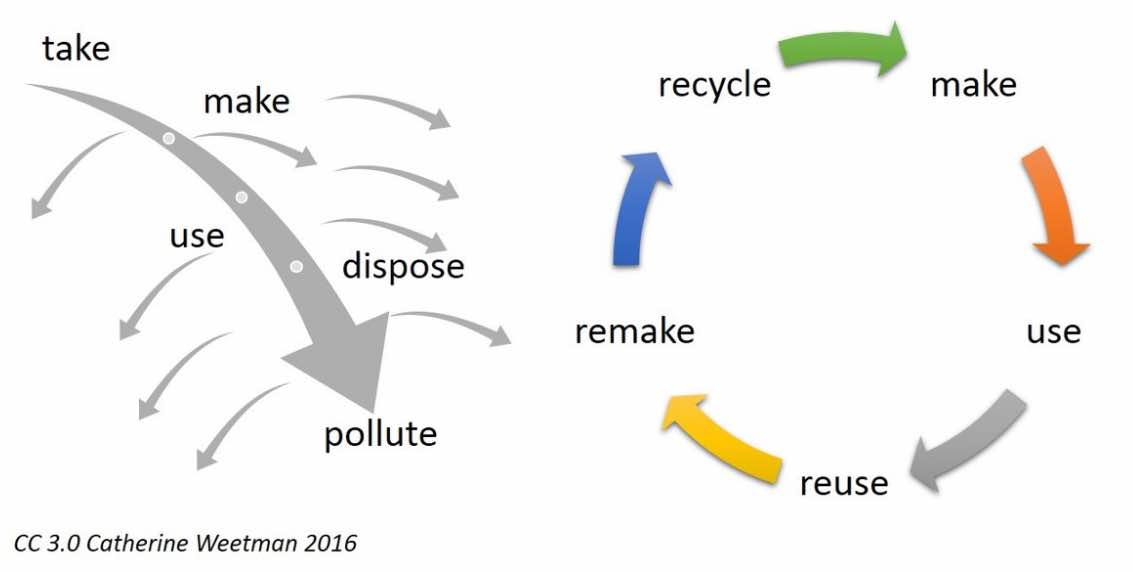You See Consumers Raising the Alarm About Sustainability
During 2019, Sustainability became a hotter topic as a growing number of consumers voiced concerns. Their main concern was about the growth of our negative environmental impact. Sustainability follows a linear model with pollution remaining as the inevitable and growing result of our consumption economy. Meanwhile the concept of circularity, adopts a reuse, remake, and recycle approach that is more sound environmentally.
According to a Nielsen report from 2018, 48 percent of consumers in the United States say that they would modify their consumption habits to reduce their impact on the environment. Consumers don’t feel that enough is being done to combat the pollution of our environment. As an alternative they are very willing to adopt the circular approach to make, use, reuse, remake, and recycle approach to help clean more pollution from our environment.

For the First Time Circularity is seen as Sustainability’s Replacement
While the environment has created new challenges for business leaders, it also presents an incredible opportunity. Consumers are actively seeking companies that adopt green business practices. Consumers want to patronize companies that share their sustainability values. To meet their green goals many business owners are beginning to adopt the circular economy approach to their business plans.
People are eager to engage directly with green businesses that are serious about reducing their carbon footprint. Our modern industrial economy was based on a straight line. It was a linear progression of make, use, dispose. Consumers movement toward accepting circularity as sustainability’s replacement ensures one thing. It ensures that consumers desires will play an integral role in molding an organization’s sustainability efforts.
How is the Growth in Business Sustainability Consumer Driven
According to the annual 2019 Trends Report released by Fjord, Accenture Interactive’s design and innovation unit. Consumers today want to be active in a company’s efforts to address climate change and pollution.
Consumers demand that organizations build sustainability into their products, services and nearly every facet of their supply chain. This is a major cultural shift toward activism and demanding the adoption of sustainable business practices.
Activists demand that today’s companies focus on making the consumer journey more circular. Rather than solely driving the organization forward while relying on existing business models. Truly sustainable organizations are those that invite consumers to join each step of the redesign and innovation process.
Truly sustainable organizations are those that invite consumers to join each step of the redesign and innovation process.
American grocery chain Trader Joe’s is just one recent example of a company that has demonstrated its commitment to keeping consumer demands top of mind when it comes to growth and innovation. Stemming from a petition that received more than 90,000 signatures from concerned consumers, the grocery chain recently announced its new goal to eliminate more than 1 trillion pounds of plastic across its stores nationwide.
How is Business Sustainability Growth Consumer Input Driven?
Allowing consumers to personally take steps toward sustainability as part of their brand experience is a strategy for building loyalty and trust. This can also be achieved by collaborating and scaling the circular strategies alongside the customers expecting these changes.
Organizations must be accountable for taking consumers along this journey but also helping them navigate the discussion surrounding sustainability today. By being transparent about an organization’s impact on the environment.
By sharing stories about traceability, sourcing and the like, transparency can go a long way. Using this knowledge to educate consumers helps companies scale their redesigned processes more effectively. This also allows consumers to be more engaged and confident when speaking about the sustainable topics that matter.
When discussing transparency, Unilever is a strong example of how companies can benefit from collaborating with consumers about their own efforts. Sustainable brands at Unilever experience 30 percent faster growth and contribute to 70 percent of the company’s growth. This further showcases the tangible business benefits of building sustainable enterprises.
Collaboration in the World Drives Progress Towards Circularity
Organizations also must be nimble — innovating for the circular economy and scaling new business processes at a faster pace than ever before. To address the sense of urgency created by heightened consumer demands and the amplification of these topics across the media, companies also must join forces with others to move the needle forward.
The Ellen MacArthur Foundation, for example, recently organized a pledge in which 250 companies including PepsiCo, H&M and others committed to increasing recycling efforts with governments to reduce the flow of plastic into our oceans. Launched in 2017 at the Copenhagen Fashion Summit, Make Fashion Circular is another such initiative, bringing fashion leaders together to collaborate on creating a new textile economy that increases the use of safe and renewable materials.
To stay ahead, companies must fully understand the power of collaboration when it comes to innovating and scaling sustainable practices, especially as new legislation creates additional pressures and consumers continue to hold organizations to a higher level of accountability.
Leading a sustainable enterprise in today’s economy is more than being mindful of business outputs, maximizing resources and reducing waste — it’s about aligning the customer experience with the circular economy, authentically engaging with customers and incorporating sustainable practices into every facet of the business. As consumption and trust are redefined by environmentally focused consumers, organizations will have to continuously react to and shift their own strategies to account for the growing number of companies joining the fight and driving their businesses forward.
Calculate Your Carbon Footprint
If you would like to calculate your Carbon Footprint, follow the link to the free carbon footprint calculator of the United States Environmental Protection Agency.








